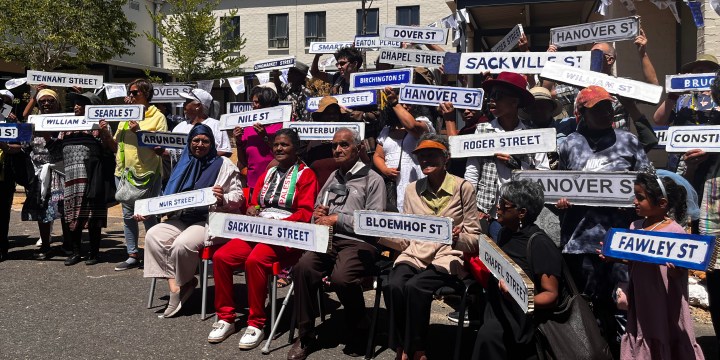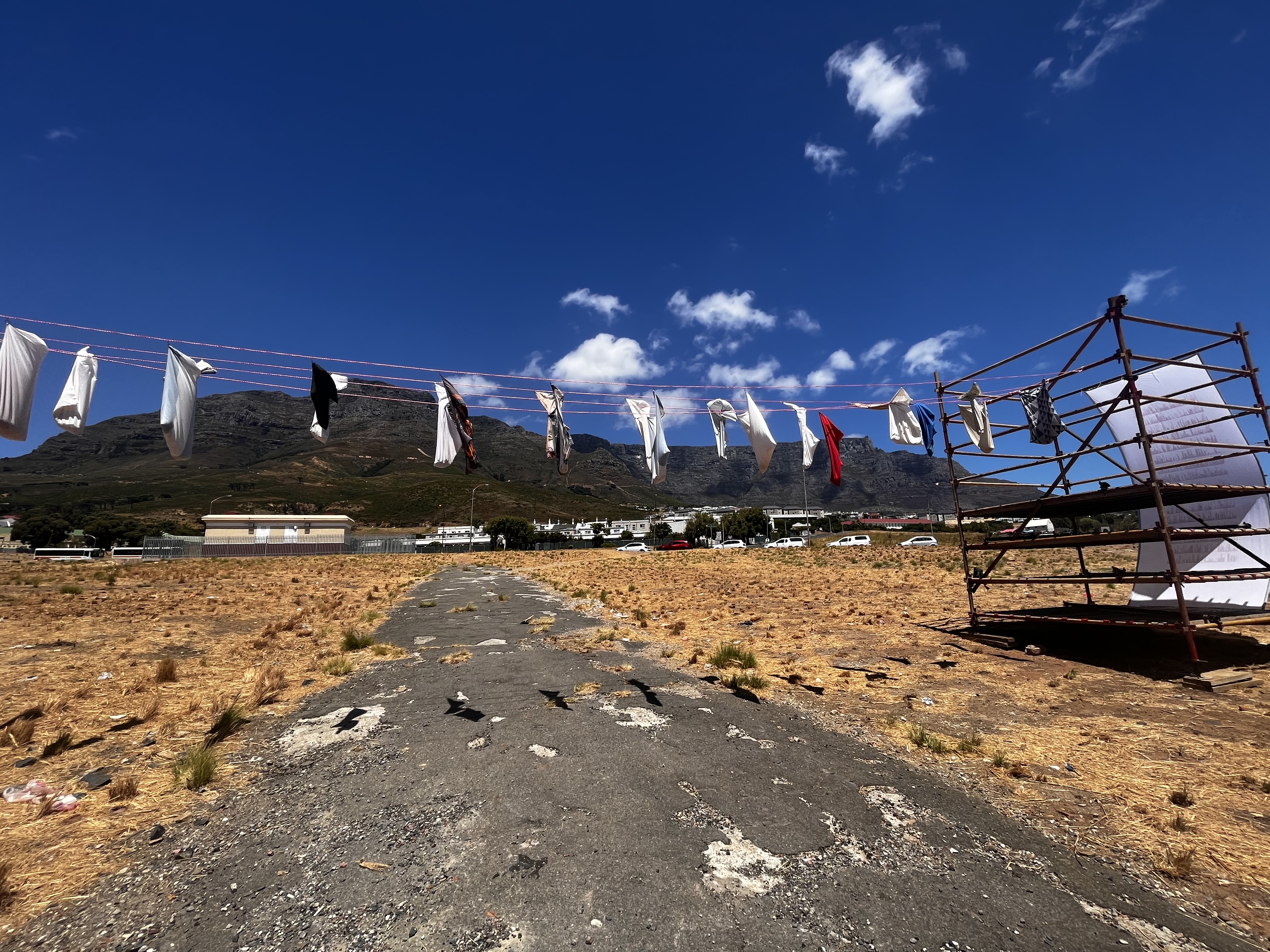DISPOSSESSION COMMEMORATION
Pillowcases and stones – heartache of brutal District Six forced removals still lingers

The forced removal of people living in areas such as District Six and Sophiatown under the apartheid regime were acts of brutal dispossession – and they should never be allowed to happen again. As claimants gathered over the weekend to remember the official start of the forced removals in District Six almost six decades ago, this was a key reminder.
The 11th of February 1966 marks the anniversary of the start of the forced removals in District Six, Cape Town. Fifty-eight years later, while some families have moved back to their beloved area, many are still waiting to return home.
Organisations such as the District Six Museum strive to keep the area and South African history alive, despite the heartache many still face. On Saturday, 10 February, the museum held its annual commemoration of the start of the removals by the apartheid regime.
On 1 February 1966, District Six – a multiracial and multicultural suburb in the Cape Town CBD – was classified as a “whites only” area under the apartheid regime’s Group Areas Act. This forced more than 60,000 people out of the area and into places such as Mitchells Plain, Manenberg, Langa and Hanover Park.
While some efforts have been made to bring back former residents, others are still waiting to return home. District Six’s oldest land claimant, Aunty Shariefa Khan, died on 26 January 2022 at age 100, without returning to the community.
On Saturday, 10 February 2024, claimants, their families and supporters of the museum gathered at a stone memorial at the Hanover student residence of the Cape Peninsula University of Technology. The site is significant as the original Hanover Street ran through it before it was bulldozed. According to new museum director Zeenat Patel-Kaskar, who started her new job on 10 January, the museum is working with the Cape Peninsula University of Technology to see what could be done to set up a more permanent memorialisation project.
According to the museum, the event was held on Saturday instead of Sunday to accommodate those who might need public transport to attend the event.
At the event, Nomvula Dlamini, deputy chairperson of the museum’s board of trustees, said it was important that “significant commemorations like the 11th of February 1966 don’t go and just pass unnoticed”. She pointed out to the young people in the audience that these commemorations needed to become intergenerational events “so that knowledge and experiences are passed on to the younger generation”.
She said the forced removals “remain stuck in our memories”, particularly for those who, like her, were of a certain age. Dlamini added that forced removals in places such as District Six, Sophiatown (Johannesburg) and Cato Manor (Durban) were a reminder to all of us that dispossession destroys communities and that it should “never, ever happen again”.
She added that not only were people removed, but they were also dispossessed of land, livelihoods and even community life.
“It is that experience of oppression and dispossession that enables us to be in solidarity with the people of Palestine, because we can see what is happening there,” she said of the ongoing war in the Middle East.
“And we know that this possession is not going to be reversible,” she said.
Supporters and claimants wrote messages and tied them to stones, which were then placed on the memorial cairn in the residence.

Pillowcases holding sand and ruins from District Six during a site art installation at the weekend. This forms part of the remembrance of the start of the forced removals in the area. (Photo: Suné Payne)

Some of the messages of support written on stones on 10 February 2024. During an event in Cape Town, claimants and supporters of District Six and the museum wrote messages of support in remembrance of the people who were forced out of District Six under the apartheid Group Areas Act. (Photo: Suné Payne)
Some claimants still waiting
“When I look on to those stones, you know that stones that lie there reminds me of the bulldozers throwing out down the dwellings where people live,” land claimant Sharifa Davids (65), who lived on Sackville Street, said at the event.
She lived in Bloemhof Flats with her family. Her family was the last of the original claimants to be moved. By the time her family was moved, Davids was married and worked at a hairdresser in Woodstock. While her immediate family – her husband and two children – were moved to Lentegeur in Mitchells Plain, her mother was moved to Valhalla Park – some 16km away.
Davids said that, ultimately, despite her pleas that her mother come with her and her family, her mother could not move with her: “That’s how they put it.”
Davids chose to look after her ill mother and had to leave her husband behind.
“So I had no choice but to go with my mother and lose my husband because my mother is more important; she’s sick,” Davids said.
“She needs all the care and a husband you can get again along the way.”
Davids is still waiting for her home in District Six. Currently, she stays with a son in Kenwyn in the southern suburbs. She said she was worried about the elderly people who were still waiting to come home to District Six.
“I want to see that the original people come in, the people that I look up to as my mother and my father,” she said.
In 2022, Daily Maverick reported that government officials including then deputy president David Mabuza promised more houses would be built to enable people to return to District Six.
Following a court process, Phase 3 of the District Six redevelopment saw 108 units being built. Other building phases include Phase 4 with 149 units built, then 173 units in Phase 5 and 145 units in Phase 6.
Read more in Daily Maverick: Heartache of forced removals lingers as claimants prepare to make ‘history’ and move back to District Six
Pillowcases and stones
After museum director Patel-Kaskar’s speech, which included references to the museum’s 30th anniversary and plans to celebrate it, a group walked to a field in District Six, near the New Apostolic Church, to view a site-specific art installation.
The art, comprising three wood-and-iron structures, was created by visual artist Ayesha Price and District Sixers, residents who work with the museum. The installation was shown for two days, Saturday and Sunday. Price told Daily Maverick the installation is part of her Masters of Fine Art exam.
She worked with the District Six residents and lives in the area. She has also worked with the museum and former residents to create art pieces about their issues.
One of the key features of her installation piece was several pillowcases hanging from two pillars.
She said that while investigating the ruins of District Six, the former residents she worked with had carried pillowcases holding collected stones and bits of earth, which were used to create sculptures.
“So the pillowcases also speak of the fact that when you think of a pillowcase, you think of leisure. You think of sleep, you think of rest. But your trauma doesn’t always allow you to do that,” said Price.
“So the pillowcases are hung with the heavy weight of the sand inside of them, and they’re dirty, but that is what you rest your head on,” she said.
“And every night when you go to sleep and I wish I was back, I remember when times were better,” she added.
Museum’s 30-year anniversary
District Six Museum will mark its 30-year anniversary this year. Surviving hasn’t been easy. During the Covid-19 lockdown, the museum was forced to close, which placed it at risk of permanent closure. The museum created a “love letters” campaign to ask for donations to keep it afloat.
Read more in Daily Maverick: The future of the iconic District Six Museum hangs in the balance – yet another Covid-19 casualty
“It is time to reflect and look at what we’re going to do to plot the way forward for the next 30 years,” Patel-Kaskar said. One of the key programmes this year would be looking at how the museum could extend school-based programmes into the curriculum.
“Throughout the year, the theme is really to remind people why the District Six museum is important and how that is going to impact lives,” she said. DM



















 Become an Insider
Become an Insider
What is it with South Africans that they just bring themselves to let the past be. The past is the past, it’s over and done, yes it may have been horrible but it’s done with. Are these people going to continue to revisit the bitterness of the past over and over and over again ? It is this continual process of digging up the painful skeletons of yesterday that prevent the country from healing and from making progress. This threat of acrimony and can’t be kept alive forever, it’s time to let go. It seems to be a limitation in the African ethos that prevents it from moving on and encourages it to hold onto grudges, so much for ubuntu. No-one expects them to forget, no-one expects them to forgive, one would just like to see the past left in the past and the bitterness allowed to temper a bit. As Christ said, “let the dead bury the dead”. It’s really time these people got over themselves and their wounds ( as ugly and painful as they may be ) and moved on, enough already for goodness sake !
The bulk of your argument leaves us with the absurd and illogical conclusion that centuries of organised disrespect against blacks and apartheid, are the only crimes against humanity which lasted for decades but did not leave any legacy of suffering. According to your comment; it just ended and vanished- not a spectre of it, physical or psychological, can be found today. Interesting take.
The legacy is self inflicted, 30 plus years on and still wallowing in self pity gets you nowhere in life and those that are still moaning and wailing are evidence of that
Yup, those that choose to live in the past will never move forward and will remain perpetually miserable